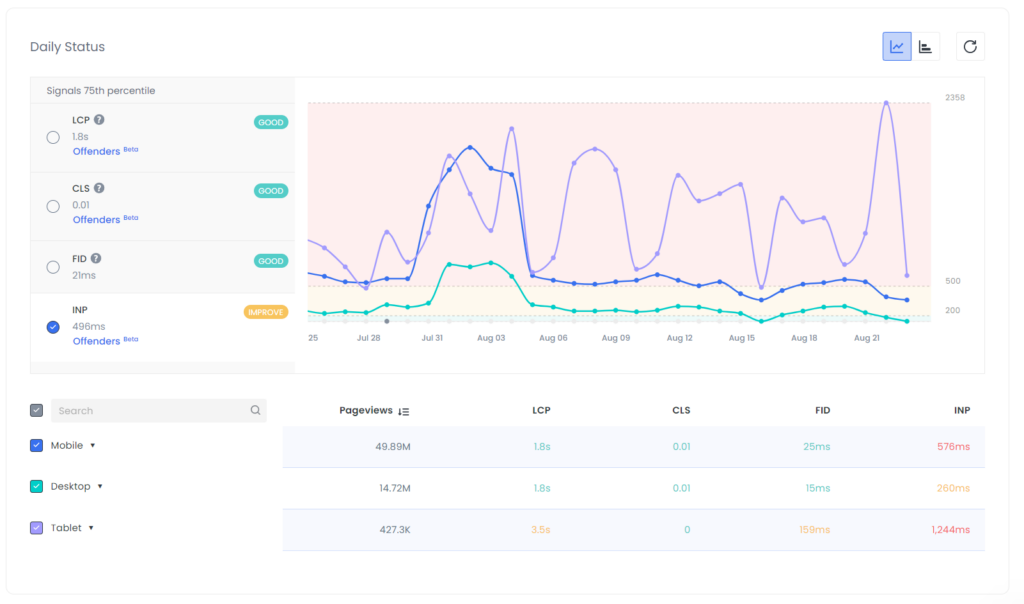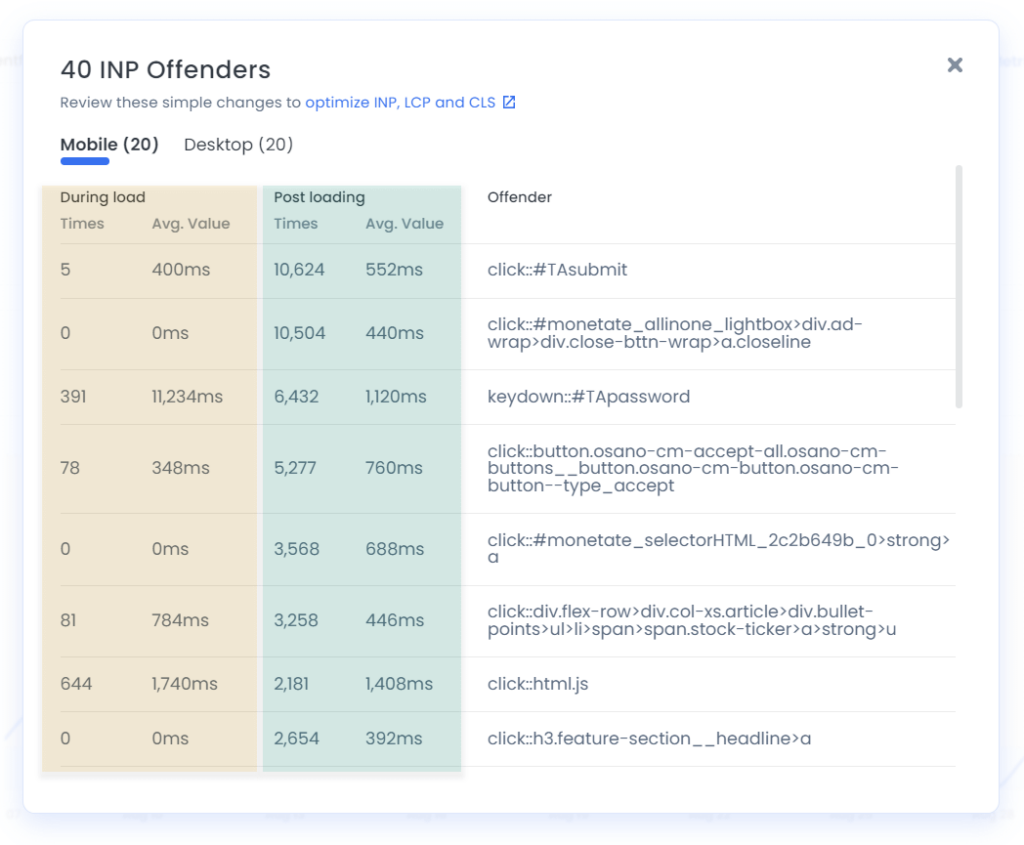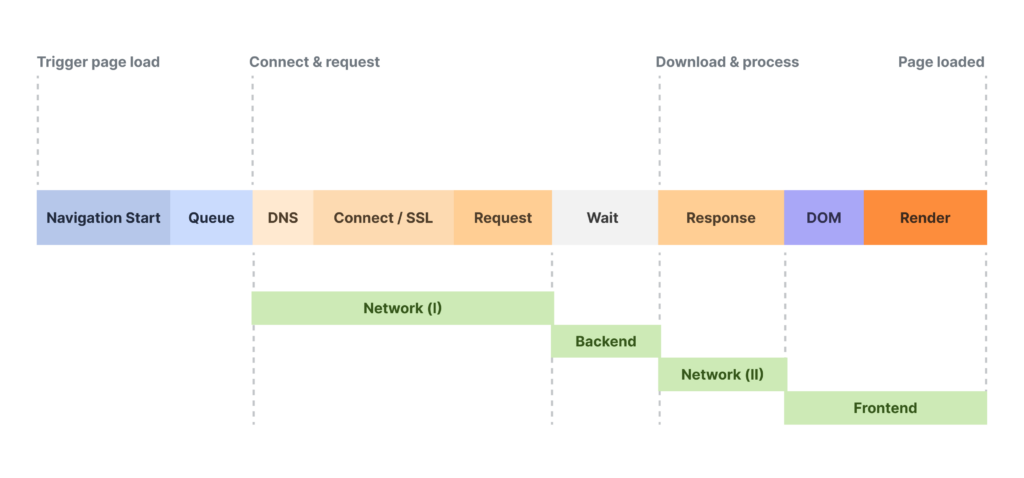In the fast-paced world of the web, optimization is key to stand out and provide the best possible user experience. Among the numerous metrics to consider, Core Web Vitals (CWV) have gained special significance. One of these metrics, Interaction to Next Paint (INP), is poised to play a crucial role in Core Web Vitals, replacing First Input Delay (FID) starting in March 2024. In this article, we will explore the importance of optimizing INP and how Marfeel, with its focus on real user data analysis (RUM), can make a difference.
What is INP and why Optimizing it is Important
INP measures a website’s responsiveness to user interactions. Essentially, it is defined as the maximum time between some of the most common user interactions with a page and the next rendering of the page. These interactions can be clicks on links or buttons, scrolls on the page or filling in a form

- A low INP score can lead to a frustrating user experience, where users feel that the page is not responding to their actions, potentially resulting in higher bounce rates and loss of traffic.
- Google has prioritized user experience by including CWV, including INP, as a ranking factor in its algorithm. Therefore, improving INP not only enhances the user experience but can also boost rankings in search results
- For content publishers, a higher INP score can result in increased audience retention, elevated conversion rates, and ultimately, enhanced financial performance. This is because we will align with our readers usage expectations precisely as they anticipate, delivering content in the manner they expect it to occur.

No one likes to wait for what needs to happen, right?
Ways to Measure INP: Lab Data vs. Field Data
There are two main approaches to measuring INP: Lab Data and Field Data (RUM).
- Lab Data is based on controlled laboratory environments and is used to detect issues in a development environment. While useful, it does not fully reflect real user experience and does not account for real-world variability.
- Field Data (RUM), or Real User Monitoring, is obtained from real users while they browse a website. These data is crucial as it represents real user experiences and form the basis of CWV metrics.
Google gives priority to Field Data when assessing a website’s performance and its impact on SEO. Therefore, measuring INP with real user data is crucial to getting an accurate picture of how users experience your site.
Why Real User Monitoring (RUM) Data is Essential
Real User Monitoring (RUM) data provides detailed insights into how users interact with your website in the real world. This includes page performance, load times, and interactions.
By analyzing RUM data, you can identify specific issues that affect the user experience and take effective measures to address them.
Marfeel offers a RUM analysis solution that allows you to collect data from real users and gain in-depth insights into how they interact with your content.
The Impact of CWV on Google and Its Algorithm
Google has made it clear that CWV, including INP, is a key factor in its ranking algorithm. A poor score in CWV can negatively impact search engine rankings.
By improving INP and other CWV metrics, you are enhancing the user experience and increasing the likelihood of your website ranking higher in Google’s search results.
How Marfeel Can Assist with Its Tool
Marfeel offers a CWV analysis tool that is based on real user data (RUM). This means you will receive accurate information about how real visitors to your site experience page speed and responsiveness.
Our solution will provide you with specific details about INP, identifying the slowest interactions and areas that require optimization.
With Marfeel, you can take concrete steps to improve INP and, ultimately, provide an exceptional user experience that benefits both your visitors and your Google products visibility as Google Search or Google Discover.

In the realm of web performance optimization, Marfeel stands out as a trailblazer. With its comprehensive analytics capabilities, Marfeel offers the unique ability to measure INP historically and evolutionarily. This means not only tracking the evolution of optimizations made by publishers but also providing detailed insights into the offenders causing these issues.

One distinctive feature offered by Marfeel is its ability to differentiate between events that occurred “During Load” and those that transpired “Post Load.” Let’s delve into why this distinction is pivotal for enhancing web performance.
During Load
During the primary loading of a web page, a flurry of activities unfolds on the main thread. This includes tasks such as HTML parsing, stylesheet analysis, and JavaScript execution. These activities can significantly influence the latency of user interactions. Understanding whether sluggish interactions transpire during this critical phase is vital because it may necessitate optimizing the initial page loading process. By doing so, we create more room on the main thread, allowing interactions to occur smoothly.

Post Load
Equally crucial are the interactions that occur after the page has fully loaded. Even though the page is technically loaded, slow interactions can make users feel like the page is unresponsive to their actions. It’s essential to identify and address these issues to ensure a smooth user experience. Additionally, this differentiation allows you to pinpoint the specific elements causing these post-load performance challenges. This, in turn, simplifies the process of optimizing those particular components, knowing that they are not affected by resource loading “during load.”
Marfeel’s capability to differentiate between these two phases (interactions during load and those after) provides invaluable insights into your website’s performance.
Summary
Unleash the full potential of your website with Marfeel’s CWV analysis tool, rooted in real user data (RUM). By accurately measuring and optimizing INP, you’ll enhance user experience, elevate your Google search rankings, keep your audience engaged and continue to improve your conversions. Marfeel provides historical insights, tracks performance evolution, and identifies performance culprits, ensuring your site is always at its best.
Experience Marfeel’s unique ability to distinguish between offenders occurring “During Page Load” and “Post Load” interactions, offering invaluable insights into web performance. Discover how Marfeel empowers you to create a seamless user experience, boost your site’s visibility, and stay ahead in the ever-competitive digital landscape.